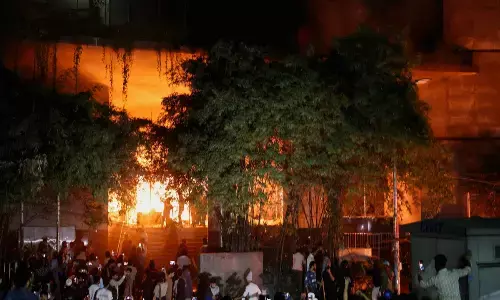None in the world is ahead of India in thorium fuelled nuclear reactor

There is a misconception that the Indian atomic energy programme has been slow in developing breeder reactors that will be fuelled by the country\'s vast thorium deposits, a foremost nuclear expert says.
There is a misconception that the Indian atomic energy programme has been slow in developing breeder reactors that will be fuelled by the country's vast thorium deposits, a foremost nuclear expert says.
"India has not been slow in developing next generation nuclear reactors that would use thorium as a fuel. Such notions are misconceived. No one in the world is ahead of us in this direction," former Atomic Energy Commission (AEC) chairman and ex-secretary Department of Atomic Energy (DAE) M.R. Srinivasan told IANS in a telephonic interview from Ooty.
Describing the claims in this regard as "publicity seeking", Srinivasan spoke of the Advanced Heavy Water Reactor (AHWR) as the latest Indian design for a next-generation nuclear reactor. In its final stages of development, the AHWR is being tested at the Bhabha Atomic Research Centre (BARC) in Mumbai as part of the third stage of India's nuclear energy programme, which envisages the use of thorium fuel cycles for generating commercial power.
"Using thorium is a time-consuming process. By itself it is not a fuel, it is a potential fuel placed in the reactor and some other fissile material is needed to convert it into Uranium 233," he pointed out.
The AHWR will be fuelled by a mix of uranium-233 converted from thorium, and plutonium. Uranium-233 is the reactor fuel for this third stage of the Indian nuclear power programme.
"The Advanced Heavy Water Reactor design has been made and it will start work next year," Srinivasan said.
The AHWRs are expected to shorten the period of achieving large-scale utilization of thorium. A second version of the AHWR, being tested, will use low enriched uranium along with thorium.
India's thorium deposits, estimated at 360,000 tonnes, far outweigh its natural uranium deposits at 70,000 tonnes. The country's thorium reserves make up 25 percent of the global reserves.
"India currently has a large data base and experimental information on thorium radiation. However, large scale commercial generation of electricity will only be possible around 2030 and we are in no way behind the others," Srinivasan said.
The key to the AWHR's development is India's second stage of nuclear power generation that envisages the use of Plutonium-239 , obtained from the first stage reactor operation, as the fuel core in fast breeder reactors (FBR). Pu-239 is the primary fissile element used in the FBR.
The former AEC chairman explained that a blanket of U-238 surrounding the FBR fuel core will undergo nuclear transmutation to produce fresh Pu-239 as more and more Pu-239 is consumed during the operation.
A 500 MW prototype fast breeder reactor is in an advanced stage of completion at Kalpakkam in Tamil Nadu and will be operational next year, he said.
"Thorium utilisation in the third stage will reduce India's dependence on fossil fuels and will be a major contribution to global efforts to combat climate change," Srinivasan said.
Besides, U-233 fuelled AHWRs will have a thorium blanket around the reactor core which will generate more U-233 as the reactor goes operational, resulting in the production of more and more uranium fuel that would help sustain long-term fuel requirements for power generation, he added.
According to Srinivasan, the currently known Indian thorium reserves can result in the generation of 358,000 gigawatt-year (GWe-yr) of electrical energy and can easily meet the energy requirements during the next century and beyond.
He said the AHWRs are also the most secure and safe reactors and could be set up close to densely-populated regions.
In this connection, Russia has offered India a new range of reactor units - the VVER-Toi (typical optimised, enhanced information) design - for the third and fourth units of the Kudankulam project in Tamil Nadu being built by its atomic power corporation Rosatom, whose Atomexpo conference gets under way in Moscow from Monday.
An inter-governmental agreement between India and Russia was signed in December 2008 for setting up Kudankulam's units 3 to 6. The ground-breaking ceremony for construction of units 3 and 4 was performed earlier this year.
"All the Russian built units at Kudankulam, including the first and second, are 'Generation 3 plus' reactors. They meet all current safety requirements," Srinivasan said.
"Their design has benefited from the review conducted of nuclear accidents like Three-Mile Island (US) and Fukushima (Japan)," he added



















